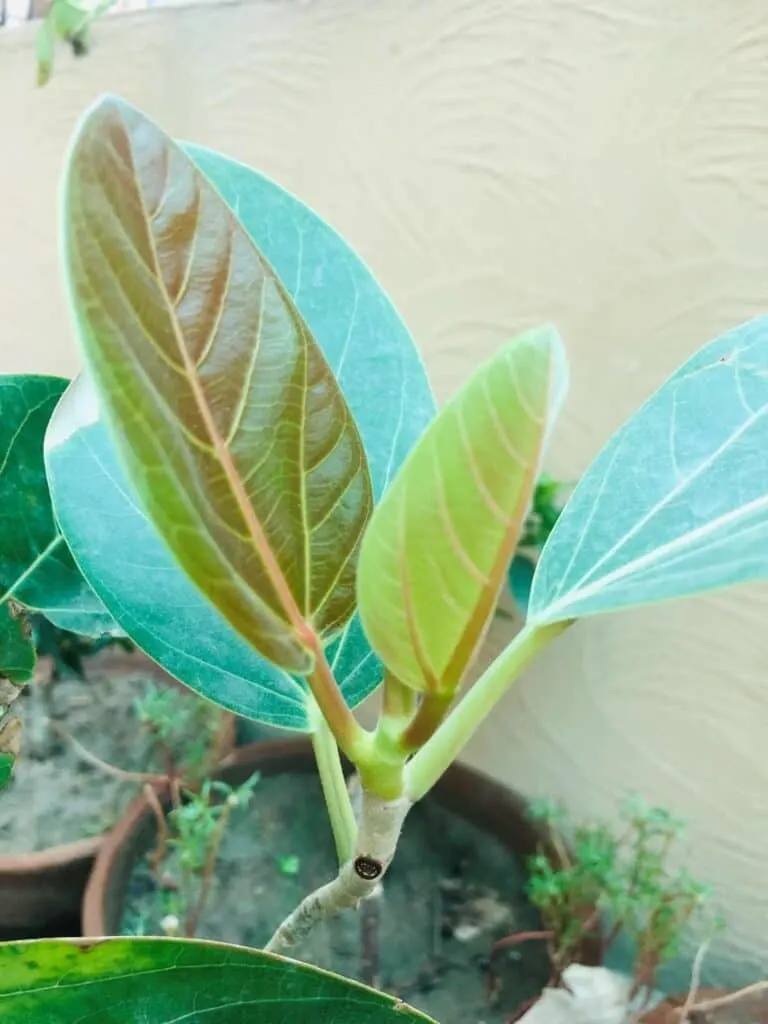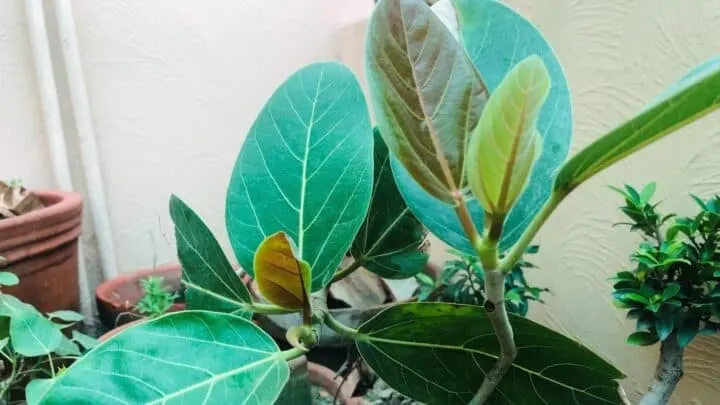Ficus Audrey, known to the world of science as Ficus benghalensis, is one extraordinary plant species.
Commonly known as the Banyan tree, it tops the list of the world’s largest trees in terms of crown spread.
Native to Southeast Asian countries, Pakistan, India, and Bangladesh, this tree is the king of all trees in their native region. Giving rise to boundless ecology under its canopy, the giant trees can grow as wide as 180 meters on average in crown diameter!
The world-famous largest Banyan tree, the Great Banyan, is located in Eastern India. What looks like a whole forest is just one single Ficus Audrey covering a colossal 18,918 square meters under its canopy!
Table of Contents
Ficus Audrey Care
Ficus Audrey thrives in well-draining sandy and/or loamy soils. It will grow well if you put it somewhere with bright indirect or direct sunlight for 6+ hours a day. Ideal growing temperatures are between 70-95°F(21-35°C). It requires regular water in moderation, so the soil is consistently moist.
Soil
Ficus Audrey likes well-draining sandy loam. It will thrive in fertile soil rich in organic matter. Soil should have good water retention as this plant prefers consistent soil moisture but will tolerate extended dry spells. The Banyan tree does particularly well in saline, shallow soils.
Much like the Ficus Religiosa, Ficus Audrey can also be seen popping out of walls and crevices in its native region. This tells us about the plant’s ability to grow in difficult sites.
This plant can grow virtually anywhere, usually on other trees’ trunks, before it grows aerial roots and grows rampantly to engulf the host tree, strangling it. This is also what gives it the name Strangler Fig.
While it will germinate even on a tree trunk, it grows aerial to absorb the nutrients and water it needs to grow.
When provided the right conditions, this plant can be a rapid grower and will need adequate soil fertility and moisture to sustain growth.
You don’t need to bother about the soil when growing Ficus Audrey in the ground. It will fare well in normal garden soils. When growing as a houseplant, use an organic mix with good drainage and aeration.
Adding ingredients like perlite, pine bark, or coco chips is excellent for drainage and will help the roots breathe well.
Light
Ficus Audrey thrives in full sunlight. It will grow well if you put it somewhere with bright indirect or direct sunlight for 6+ hours a day. It does not like low-light conditions and will grow small leaves on leggy stems. It can tolerate very strong sunlight well.
The Banyan tree, in its native region, has grown for thousands of years with 12 hours of sun all day, year-round. It has acclimatized to thrive in places that get a lot of sun.
Placing it in a low-light corner, as you could with a Ficus Elastica, is not an option. If growing outdoors, give it a spot that gets unobstructed sunlight for most of the day.
Do not grow a Banyan tree near a wall or your house unless you want its roots to be strangling your home in a few years. Always give it wide open ground so it gets a lot of sun and can grow its king-sized canopy freely.
When growing indoors, place this plant right next to a sunny window. There’s no other way you can go about it. Even grow lights don’t work with such plants that can grow really big really quickly.
Watering
Ficus Audrey requires regular water in moderation. Although it can tolerate severe dry spells that easily kill other plants, it will thrive if its soil is kept moist consistently. Don’t wait for its soil to dry out completely, and give it a drink when the top layer of soil gets dry.
Compared to other giant houseplants, Ficus Audrey can be a lot more forgiving if you make a few mistakes in watering it.
It can tolerate underwatering but won’t like it a bit if overwatered. Overwatering can lead to sudden leaf drop, brown patches on foliage, and other fungal infections.
Even then, this plant can quickly spring back to being healthy if watering is regulated on time.
You want to keep its soil evenly moist at all times. If growing in the ground, you can mulch the soil around it during dry months. Remember to wind up the mulch material when the rainy season arrives.
If growing in a pot, cover the soil with pebbles, chips, or other material to help the soil retain its moisture.
The best way to time your watering is to observe the soil moisture every two days for two weeks. This plant requires water when the top 1-2 inches of soil get dry.
You can use the finger test to check for soil moisture every two days and create a schedule for watering during the summer and winter.
Temperature
Hailing from one of the hottest tropical regions of the planet, Ficus Audrey loves hot temperatures. It cannot tolerate frost and while stops growing in temperatures below 55°F (12°C). Ideal growing temperatures are between 70-95°F(21-35°C). It can only be grown outdoors in USDA zones 10-12.
Banyan trees are famous for growing rampantly during the hot months of June and July in their native region. The Monsoon weather system and Ficus Benghalensis have a very strong bond.
In Southeast Asia, when average monthly temperatures hit 95°F(35°C) in June and July, and the Monsoon brings high humidity to the region, the Banyan tree vivifies with color.
If you’re growing this plant in colder regions, it will have to be brought indoors in a warm and humid location to survive the winter.
Humidity
The Banyan tree likes humidity and will only grow well when humidity is above 40-50%. It requires high humidity to develop aerial roots and establish them. This plant will stop growing and may die if kept in very dry environments.
When it comes to the Ficus Audrey, humidity is a critical factor for the plant to grow well.
In nature, the plant needs a few months of high humidity whereby it can successfully grow aerial roots and help them reach the ground and get established.
This natural high humidity period comes in the form of the Monsoon system, which spans July-August. In these months, humidity rarely falls below 50% in places Ficus Audrey grows naturally.
If you’re not located in a tropical climate, you will have to make up for this plant’s humidity requirements artificially.
Misting the foliage is not a very effective way to fulfill the humidity requirements for this plant. Using a humidifier or a pebble tray are more effective alternatives.
Whether growing in the ground or in the soil, it is a common practice to place rocks, bricks, or broken pot pieces around the trunk of a Ficus Audrey to induce healthy aerial roots and to maintain suitable humidity levels for the plant.

When the plant grows aerial roots, you can prevent them from drying out and help them reach the soil quickly by inserting them in a plastic straw and putting the straw in the soil.
The inside of the straw with high humidity is a safe passage for the aerial root to grow into the soil quickly.
Fertilizer
You can start fertilizing your Ficus Audrey once it has been growing in its place for a year. It will respond well to a monthly dose of balanced 20-20-20 fertilizer. Fertilize this plant only during the growing season, and don’t forget to dilute, as overfeeding can lead to plant damage.
Using organic compost or slow-releasing fertilizer is recommended for Ficus Audrey. When adding the fertilizer, be careful not to put the fertilizer too near the trunk or aerial roots of the plant.
Also, water the plant well before adding fertilizer to ensure the fertilizer does not burn the roots.
Growth
In nature, Ficus Audrey trees can grow as tall as 30 meters and with canopies as wide as 180 meters in diameter. They are fast-growing plants, and the average Banyan tree will grow into a full-sized tree in five years. When grown in a pot, this plant will grow up to 7-10 feet tall.
While these trees hardly grow an inch in the winter, they can increase massively in height and foliage in the summer months.
Banyan trees start growing vigorously once they are well-established in the ground or in the pot. So if you’ve got transplanted a young plant or just propagated one, be really patient as it will take at least a year to start growing with pace.
The leaves are elliptic shaped, and 2-6 inches long and have a fuzzy surface. The foliage has a medium green color with prominent light green veins. New foliage growth looks like large red chilies at the tip of each stem.

Potting
Ficus Audrey are big plants and will prefer bigger pots. Unless you want to grow this plant as a Bonsai tree, you must give it a deep and wide pot to spread its roots and grow aerial roots. Adequate drainage is a must. Clay pots are recommended over other pots.
When potting Ficus Audrey, you should choose a pot that is at least 12 inches in diameter and is high enough for the roots to grow deep and sustain a tall plant.
Before adding the soil into the pot, put some pebbles or a layer of small rocks in the lower part of the pot. This will ensure the pot drains well and the drainage hole never gets clogged.
As your plant gets bigger, you will need to repot it to a bigger container every two years.
Pruning
Pruning is an important part of Ficus Audrey care. This plant tends to outgrow its space pretty quickly and is required to be pruned back to size to maintain its good looks and size. Pruning must be done in spring or early summer for best results.
When grown as a houseplant, Ficus Audrey will need more frequent pruning than most other plants.
Pruning or defoliating techniques can also be used to make the plant grow denser foliage with smaller leaf sizes.
Remove all dead plant matter, dried up aerial roots, and dried leaves in pruning sessions.
When a cut is made, Ficus Audrey leaves and stems can release harmful, irritating white sap.
So while you prune your plant, make sure the sap doesn’t come into contact with your skin, and kids or pets don’t touch it.
Ficus Audrey Propagation
Ficus Audrey can easily be propagated by rooting stems in water. Propagation can only be done in the spring or high heat and humidity seasons. Cuttings should be placed in drinking water in a warm and bright place. Stems will root within 6 weeks.
Propagating this species is very easy and can be done by taking cuttings and planting them in moist soil or even letting them hang in water until they root and then transplant them to the soil.
Choose a healthy hardwood stem that has 4-5 leaves on it. Make a slanting cut to obtain the stem cutting. Always use clean and sharp pruners for this process.
Conclusion
This colossal plant is fairly easy to grow and one of the best species to grow as a houseplant. The bold green leaves and magnificent aerial roots of the Ficus Audrey are something to admire.
All you need is a big pot and the right humidity, and see this plant grow exponentially and touch the ceiling pretty soon!

Frequently Asked Questions About Ficus Audrey
Will chopping off aerial roots harm my Ficus Audrey?
Aerial roots are grown as a source of extra moisture and nutrients as the tree grows bigger, but the primary purpose of aerial roots is to act as a supporting structure for the thick branches crowning out of the main trunk. If you have a small plant, you can chop them off without any serious repercussions.
Why is my Ficus Audrey not growing?
Even when provided all the right conditions, young ore recently transplanted Ficus Audrey plants require some time to get established in the soil. Until they get well-established, growth will be very slow or even non-existent.

Daniel has been a plant enthusiast for over 20 years. He owns hundreds of houseplants and prepares for the chili growing seasons yearly with great anticipation. His favorite plants are plant species in the Araceae family, such as Monstera, Philodendron, and Anthurium. He also loves gardening and is growing hot peppers, tomatoes, and many more vegetables.


